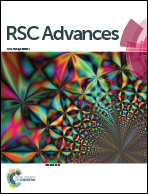Controlled assembly of Bi2S3 architectures as Schottky diode, supercapacitor electrodes and highly efficient photocatalysts
Abstract
Bismuth sulfide (Bi2S3) microflowers have been successfully fabricated through a one-pot hydrothermal method. The structures and morphologies of the as-obtained products are characterized by X-ray diffraction (XRD), field-emission scanning electron microscopy (FESEM), transmission electron microscopy (TEM) and Raman spectroscopy. The experimental results show that Bi2S3 microflowers are composed of many microrods with lengths of 18–20 μm. Metal/semiconductor/metal (MSM) sandwich structures are fabricated, and the current–voltage (I–V) characteristics exhibit a clear back-to-back Schottky-diode behavior. The galvanostatic charge–discharge performance illustrates that the prepared Bi2S3 microflowers exhibit good performance for discharge efficiency at current densities from 1 mA cm−2 to 10 mA cm−2. Furthermore, the as-synthesized Bi2S3 microflowers are also used as the efficient UV-light photocatalysts for the photocatalytic degradation of methylene orange (MO) under light illumination, which shows almost complete degradation (∼95%) of MO dye.


 Please wait while we load your content...
Please wait while we load your content...